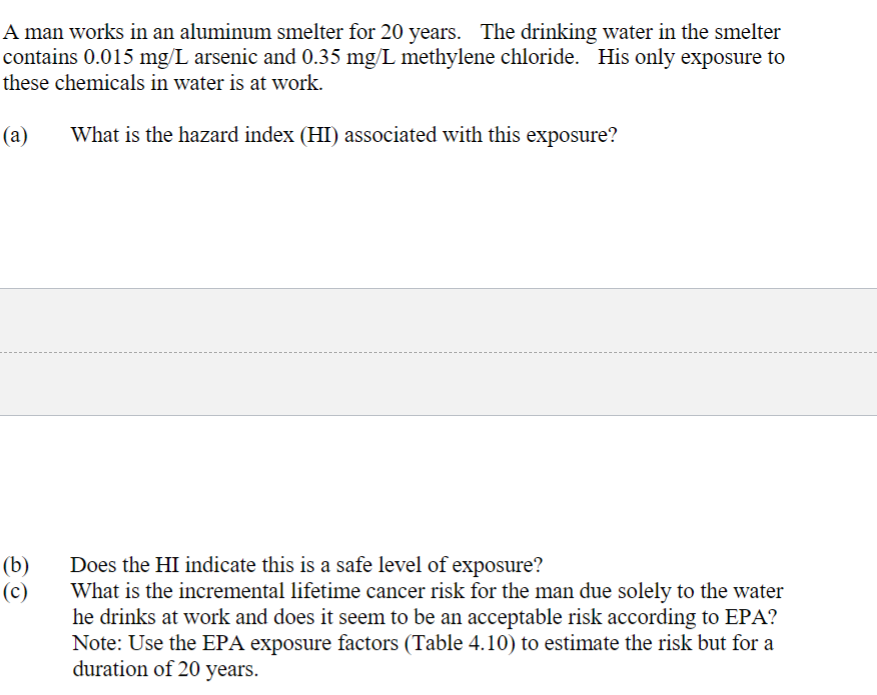A man works in an aluminum smelter for 20 years. The drinking water in the smelter contains 0.015 mg/L arsenic and 0.35 mg/L methylene chloride. His only exposure to these chemicals in water is at work. What is the hazard index (HI) associated with this exposure? (a)
A man works in an aluminum smelter for 20 years. The drinking water in the smelter contains 0.015 mg/L arsenic and 0.35 mg/L methylene chloride. His only exposure to these chemicals in water is at work. What is the hazard index (HI) associated with this exposure? (a)
Introduction to Chemical Engineering Thermodynamics
8th Edition
ISBN:9781259696527
Author:J.M. Smith Termodinamica en ingenieria quimica, Hendrick C Van Ness, Michael Abbott, Mark Swihart
Publisher:J.M. Smith Termodinamica en ingenieria quimica, Hendrick C Van Ness, Michael Abbott, Mark Swihart
Chapter1: Introduction
Section: Chapter Questions
Problem 1.1P
Related questions
Question

Transcribed Image Text:A man works in an aluminum smelter for 20 years. The drinking water in the smelter
contains 0.015 mg/L arsenic and 0.35 mg/L methylene chloride. His only exposure to
these chemicals in water is at work.
(a)
What is the hazard index (HI) associated with this exposure?
(b)
(c)
Does the HI indicate this is a safe level of exposure?
What is the incremental lifetime cancer risk for the man due solely to the water
he drinks at work and does it seem to be an acceptable risk according to EPA?
Note: Use the EPA exposure factors (Table 4.10) to estimate the risk but for a
duration of 20 years.
Expert Solution
Step 1
Given that-
Concentration of Arsenic=0.015 mg/L
Concentration of methylene chloride=0.35 mg/L
The exposure time=20 years
Average body weight of man= 70 kg (supposed)
Volume = 1 L/day (supposed)
(a)
The hazard index (HI) is calculated as the sum of hazard quotients of both the pathways and their similar toxic effects.
Firtst of all the, average daily dose are-
Reference dose from standard data-
Trending now
This is a popular solution!
Step by step
Solved in 3 steps

Recommended textbooks for you

Introduction to Chemical Engineering Thermodynami…
Chemical Engineering
ISBN:
9781259696527
Author:
J.M. Smith Termodinamica en ingenieria quimica, Hendrick C Van Ness, Michael Abbott, Mark Swihart
Publisher:
McGraw-Hill Education

Elementary Principles of Chemical Processes, Bind…
Chemical Engineering
ISBN:
9781118431221
Author:
Richard M. Felder, Ronald W. Rousseau, Lisa G. Bullard
Publisher:
WILEY

Elements of Chemical Reaction Engineering (5th Ed…
Chemical Engineering
ISBN:
9780133887518
Author:
H. Scott Fogler
Publisher:
Prentice Hall

Introduction to Chemical Engineering Thermodynami…
Chemical Engineering
ISBN:
9781259696527
Author:
J.M. Smith Termodinamica en ingenieria quimica, Hendrick C Van Ness, Michael Abbott, Mark Swihart
Publisher:
McGraw-Hill Education

Elementary Principles of Chemical Processes, Bind…
Chemical Engineering
ISBN:
9781118431221
Author:
Richard M. Felder, Ronald W. Rousseau, Lisa G. Bullard
Publisher:
WILEY

Elements of Chemical Reaction Engineering (5th Ed…
Chemical Engineering
ISBN:
9780133887518
Author:
H. Scott Fogler
Publisher:
Prentice Hall


Industrial Plastics: Theory and Applications
Chemical Engineering
ISBN:
9781285061238
Author:
Lokensgard, Erik
Publisher:
Delmar Cengage Learning

Unit Operations of Chemical Engineering
Chemical Engineering
ISBN:
9780072848236
Author:
Warren McCabe, Julian C. Smith, Peter Harriott
Publisher:
McGraw-Hill Companies, The